Notes from the Field: July, 2019
Nature Cure Clinical Pearls
Jared L. Zeff, ND, VMNI, LAc
The following is a not an article prepared for a medical journal. Not every statement of fact is cited or referenced. This is a commentary on the medicine, a running set of observations about practice in the field. It’s not meant to be a peer-reviewed presentation; rather, these are notes and thoughts from a practicing naturopathic physician, a primary care doc in general practice.
A Case of Pneumonia
“Jack” was coughing when he came in – that characteristic harsh, brassy cough, but with mucus production. He said it hurt to cough. I took the history of this illness. He had a cold, he said, and it went into his chest. He was starting to feel a bit better, when he suddenly got a fever and it seemed harder to breathe. His cough changed. It was deeper and was beginning to hurt. His wife told him to come in and see me.
He coughed, and said it hurt and that was why he was here. I took him into my exam room, took his temperature, O2 saturations, and blood pressure, listened to his lungs, and so forth. He had a slight fever and appeared to have pneumonia. I immediately gave him a dose of Bryonia 30C. A minute later he coughed again, and the sound was softer. I asked how it felt, and he replied with some incredulity that it did not hurt, at least not nearly as it had just a minute before. I put him onto a hydrotherapy table for a constitutional treatment while I prepared a botanical medicine for him (Asclepias, Inula, Glycyrrhiza, Prunus, Lobaria) and sent him home with that and a vial of Bryonia 30C. I told him to take the botanical – 50 drops in a little water every 3-4 hours – and the Bryonia as needed for the cough. He was to call me if he felt any worse, and to call me either way the next day.
I had a preceptor with me that day, a 4th-year student from one of our colleges. As we were discussing the case, the student was concerned that I was not following the standard of care. I asked her what she meant. She said that the standard of care was to refer a suspected pneumonia, and that the patient would be worked up and probably given an antibiotic. Wasn’t I worried? I replied, “Whose standard of care?” She said, “THE standard of care.” I then asked, “Naturopathic standard of care or conventional standard of care?” She did not know what I was talking about. I explained to her that I was a naturopathic physician, not a medical doctor, and that I was governed by a different statute, a different board, had a different education under a different philosophy of medicine, and therefore had a different standard of care. Why should I be governed by a standard of care that was conventional, not naturopathic? She was getting more confused. Then she brought up the question of primary care practice: “Doesn’t primary care require that we practice the standard of care?” This was going to take a minute. I suggested that we talk about this over lunch, and we went on to the next patient.
The American Academy of Family Physicians (AAFP) defines primary care as follows:
Primary care is that care provided by physicians specifically trained for and skilled in comprehensive first contact and continuing care for persons with any undiagnosed sign, symptom, or health concern… Primary care includes … diagnosis and treatment of acute and chronic illnesses… and utilizing consultation or referral as appropriate.
PCPs & Standards of Care
I attended NCNM between 1975 and 1979. I was and have always been a primary care, general practice, naturopathic physician. I do just what the AAFP describes as primary care. An undiagnosed patient comes into my clinic and I determine the nature of the problem and either treat them or refer them. That is primary care. Naturopathic standard of care must be different from conventional standard of care because we are different from conventional physicians. If that were not the case, what is the point of having a separate profession? Why create and maintain all this infrastructure, including our own schools, statutes, boards of examiners, exams (NPLEX) and accrediting agency (CNME), and all the rest, if we are just going to provide the same care as nurse practitioners or physician assistants?
In 1991, Thom Kruzel was president of the AANP and generated our first “Standards of Practice” document, which was revised in 2000 and 2011. That paper states that appropriate care consists of:
- Providing each patient with an understanding of his or her disease and/or health prognosis;
- Re-evaluating the effectiveness of treatment plans in a timely manner defined in the context of the potential risks to the patient;
- Modifying failed plans promptly;
- Providing or offering a referral to other appropriate health care providers in the absence of timely progress.
He adds that this is to be done within the scope and training of the naturopathic doctor. There is no requirement to adhere to a conventional medical standard of care; this would be absurd unless one is practicing in a jurisdiction that provides the privilege of prescribing a vast range of pharmaceuticals – which is currently the case in only about 4 or 5 of our 22 licensed states and provinces.
The point of all of this is that there is a naturopathic standard of care and that it is based upon the vast array of different therapeutic interventions in which we are trained. The essence of the naturopathic standard of care is to treat the patient in a logical and rational manner regardless of the therapeutic modalities employed, to change your approach in a timely manner if the patient is not responding appropriately (which may require a referral), and to document what you are doing. One can treat pneumonia or any other infection with hydrotherapy, homeopathy, botanical medicine, physiotherapy, or even antibiotics (if that is within the scope of your practice in whichever state you reside).
It is disturbing to me that many of our young students are convinced that we must somehow conform to a conventional standard of practice. A moment’s reflection should demonstrate that this makes no sense. Naturopathic medicine is defined as a separate and distinct branch of the healing arts:
Naturopathic medicine is a distinct system of primary health care – an art, science, philosophy and practice of diagnosis, treatment and prevention of illness. Naturopathic medicine is distinguished by the principles, which underlie and determine its practice. These principles are based upon the objective observation of the nature of health and disease, and are continually reexamined in the light of scientific advances. Methods used are consistent with these principles and are chosen upon the basis of patient individuality. Naturopathic physicians are primary health care practitioners, whose diverse techniques include modern and traditional, scientific and empirical methods. (from the AANP definition of naturopathic medicine, 1989)
If we are to survive, and to maintain our hard-won accomplishments and the resurrection of our profession, we must be able to understand and acknowledge that we are a separate and distinct practice, based upon a separate and distinct philosophy of medicine that is valid and valuable. If this is not the case, then what is the point of attempting to maintain ourselves as a separate and distinct profession?
By the way, the pneumonia patient was significantly better the next day – no fever and a much softer cough – and the pneumonia was completely resolved within the following week.
A Case of DIPG
Early this month a young mom, a widow, brought me her 8-year-old daughter. The child was having trouble walking, and her speech was slurry. And this was an improvement. About 3 weeks prior, in mid-June, her daughter started demonstrating balance problems. She was hesitant to drink, even though it was sunny and warm. She assumed dehydration and took her daughter to Urgent Care. They saw nothing wrong, and she brought her daughter, whom I’ll call “Alice,” home. She was convinced something was wrong, and set up an appointment with her PCP, who did some neurological testing, and also decided there was nothing wrong. She took Alice to the park, but her daughter seemed dazed, out of it, and her personality seemed different. So mom next took her to the ER, where it was noticed that her eyes were not tracking properly. Because of hematuria they thought she had a bladder infection. Then Alice began to lose the ability to speak or walk. An MRI revealed a pontine brain tumor. A neurological consult resulted in a diagnosis of DIPG, or diffuse intrinsic pontine glioma.
DIPG is the leading cause of death from pediatric brain tumors. The mom was told that there is currently no effective treatment for DIPG, and no chance of survival. The oncologist offered treatment, but assured her that it would not work. A second opinion rendered the same prognosis and recommendation. The physician told her that he would support anything the mom wanted to do, even taking her to a naturopath. They just had nothing to offer. He said that she would only get worse. By that point, her mom had to carry Alice.
Doctor Mom
But Alice walked into my office as if she were intoxicated. My neurological exam demonstrated that her eyes were unable to track, to follow my moving finger. Mom explained that she had been researching on the internet and had come up with a protocol, and that as she started applying it Alice began to regain some function. Although her pronunciation was incorrect, she explained to me the rationale for each of the items she was using, including boswellia, resveratrol, bromelain, quercetin, EGCG (green tea extract), vitamins E, B12, and D3, ginseng extract, blueberry extract, probiotics, curcumin, selenium, berberine, proanthocyanidins, and ibuprofen. She had put Alice on a vegan, non-GMO diet and was giving her fresh juices. She explained to me how anthocyanidins had anti-tumor and apoptotic capabilities and how bromelain would help open the blood-brain barrier. Her treatment theory was to reduce toxins, boost the immune system, and to provide healthy fats and anti-tumor materials.
Mom is a night waitress, who spends her days researching her daughter’s tumor and its possible treatment; she is aided by her sister and dad in caring for Alice. She has no college, but is rapidly becoming an expert in the treatment of DIPG.
Weekly Visits
I agreed to see Alice once a week. At each visit, her mom would explain to me the latest things she had learned. I have been repeatedly amazed.
At her second visit 1 week later, Alice’s mom explained to me that a mutation of histone H3, which can cause an overexpression of the gene, was a common factor in DIPG and how all of the therapeutic substances she was using are H3 and H4 inhibitors. Without a biopsy they could not determine whether Alice had an H3 or H4 mutation, and a biopsy was not likely. She had added MSM (methylsulfonylmethane), glutathione, and sulphoraphane during the week. On this visit I detected improvement in Alice’s eye tracking. But her mom noted that she had lost some control in her right arm and leg over the past 2 days. I added a homeopathic medicine.
During the next visit she reported that the homeopathic seemed to restore right limb function and that Alice was improving again. She was laughing but her speech fluctuated, as did her balance. Mom reported that Alice had a history of head injury – 3 concussion earlier in her life. I added a drainage protocol for brain repair, the first in a sequence of proprietary homeopathic formulations.
A week later, mom reported that Alice had shown more improvement. She had more energy, her nystagmus was improving, and she could lift her right arm above her head, which Alice demonstrated for me. Mom further explained the histone H3 mutation. Specifically, it is an H3K27M mutation. K27 is the code for lysine. Three histones are affected, which causes the lesion to defectively create arginine rather than lysine. Hence, mom is supplementing L-lysine and reducing L-arginine foods. Furthermore, there are sub-mutations: H3S13A, found in 75% of DIPG, and a few others. Apparently, there is an overexpression of CDK4 and CDK6; the P53 anti-tumor protein is also overexpressed, leading to malignancy and tumor cell growth; NFĸB is overexpressed as well, and she is researching substances to counter this. This waitress knows vastly more about this problem than I do, and probably more than most neurologists. I provide the next phase of the drainage protocol for traumatic brain injury, which seems to be helping.
Closing Comments
I’ve seen Alice 4 times now, once each week. I have no idea where this is going, but Alice is clearly improving, against all odds. When she left the hospital, she could hardly walk. She had lost a lot of cognitive function, much of which she has regained. She was constipated, with a bowel movement every 5 days; now it’s 1-2 per day. She can now feed herself and can swallow pills. Her eyes are bright and open, and the dark circles have dissipated. Her motor skills are improving, her right arm is more functional, and she can handle the bathroom by herself. And her personality is back. Clearly, mom’s regimen is producing a positive effect.
I thought it worth reporting.
Respectfully,
Jared L. Zeff, ND, VNMI, LAc
 Jared L. Zeff, ND, VNMI, LAc, is a licensed doctor of naturopathic medicine and a licensed acupuncturist. In addition to functioning as Medical Director at the Salmon Creek Naturopathic Clinic in Vancouver, WA, Dr Zeff teaches on the faculty at National University of Natural Medicine in Portland, OR, where he was also Dean from 1988 to 1993, and holds a professorship in Naturopathic Medicine. Dr Zeff is a graduate of the University of California, NCNM, and the Emperor’s College of Traditional Oriental Medicine. He, along with Pamela Snider, is the author of the AANP’s Definition of Naturopathic Medicine, and the Therapeutic Order concept.
Jared L. Zeff, ND, VNMI, LAc, is a licensed doctor of naturopathic medicine and a licensed acupuncturist. In addition to functioning as Medical Director at the Salmon Creek Naturopathic Clinic in Vancouver, WA, Dr Zeff teaches on the faculty at National University of Natural Medicine in Portland, OR, where he was also Dean from 1988 to 1993, and holds a professorship in Naturopathic Medicine. Dr Zeff is a graduate of the University of California, NCNM, and the Emperor’s College of Traditional Oriental Medicine. He, along with Pamela Snider, is the author of the AANP’s Definition of Naturopathic Medicine, and the Therapeutic Order concept.










